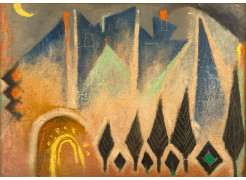Additional info:
Naim Ismail occupies a central position within the development of Syrian modern art after independence. Educated in Istanbul and subsequently in Rome, he formulated a visual vocabulary that fused geometric abstraction with iconographic references drawn from Islamic ornament and scenes of everyday life. His painting balanced figuration and symbolism, frequently embedding subtle socio-political commentaries that reflected his preoccupation with national identity and the collective experience of modern Syria. Upon his return to Damascus, Ismail assumed a dual role as artist and cultural administrator. He worked as artistic director for a number of publications before being appointed Director of Fine Arts at the Syrian Ministry of Culture, a position he held until his death in 1979. In parallel with his studio work, he completed several large-scale public commissions, among them the façade of the Trade Union Building in Damascus and the monumental decoration of the Euphrates Dam at Tabqa. His wide-ranging production—which includes drawings, mosaics, frescoes and publication designs—reveals a consistent pursuit of equilibrium between aesthetic structure and social message. Throughout his career, Ismail maintained an ideal of synthesis in which abstraction and vernacular motifs coexisted within a distinctly humanistic framework. His works are represented in major institutional and private collections, including the Barjeel Art Foundation and the Atassi Foundation, confirming his enduring significance in the visual culture of twentieth-century Syria.
-
Jan Ziemski
1920 - 1988 -
Toma Roată
b. 1941 -
Tara von Neudorf
b. Luduș, Romania, 1974 -
Gheorghe Ilea
b. Bucea, Romania, 1958 -
Rodica Maniu Mützner
Bucharest, Romania, 1890 - Bucharest, Romania, 1958
